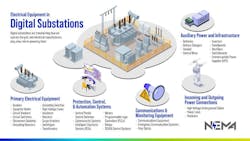NEMA Publishes Standards Blueprint for Digital Substations to Support Grid Modernization
The National Electrical Manufacturers Association (NEMA) has released a set of standards aimed at supporting the development and deployment of digital substations in the United States. The initiative responds to growing electricity demand driven by trends such as data center expansion, electric vehicle adoption, and the increased use of artificial intelligence.
Digital substations use real-time data, automation, and standardized communication protocols to modernize the traditional electrical grid. These technologies can help improve grid responsiveness, facilitate integration of renewable energy sources, and enhance service reliability.
Despite these potential benefits, the implementation of digital substations poses challenges, including interoperability issues between equipment from different vendors and the need for complex custom engineering. These factors can lead to increased costs and longer deployment timelines.
To support more efficient and scalable deployment, NEMA has introduced a series of Basic Application Profiles (BAPs) intended to promote interoperability and streamline engineering processes. The profiles focus on functions such as fault location, isolation, and service restoration (FLISR):
-
BAP for FLISR in a Looped Single Line Feeder with Communications Loss (NEMA US 80061-2025)
-
BAP for Fault Isolation including DER Connectivity (NEMA US 80064-2025)
-
BAP for FLISR in a Looped Single Line Feeder (NEMA US 80047-2024)
According to NEMA, U.S. electricity demand is projected to grow by approximately 2% annually, resulting in a 50% increase by 2050. The organization positions these new BAPs as tools to help utilities and manufacturers address this projected growth through digital infrastructure.
Patrick Hughes, Senior Vice President of Strategy, Technical, and Industry Affairs at NEMA, stated that the new standards are intended to help utilities deploy digital substations more efficiently and cost-effectively.
The BAP documents were developed by NEMA’s Technical and Industry Affairs team and are part of the organization’s broader efforts to support grid modernization and resilience.
